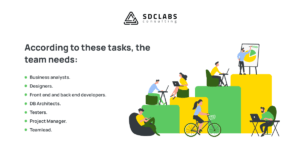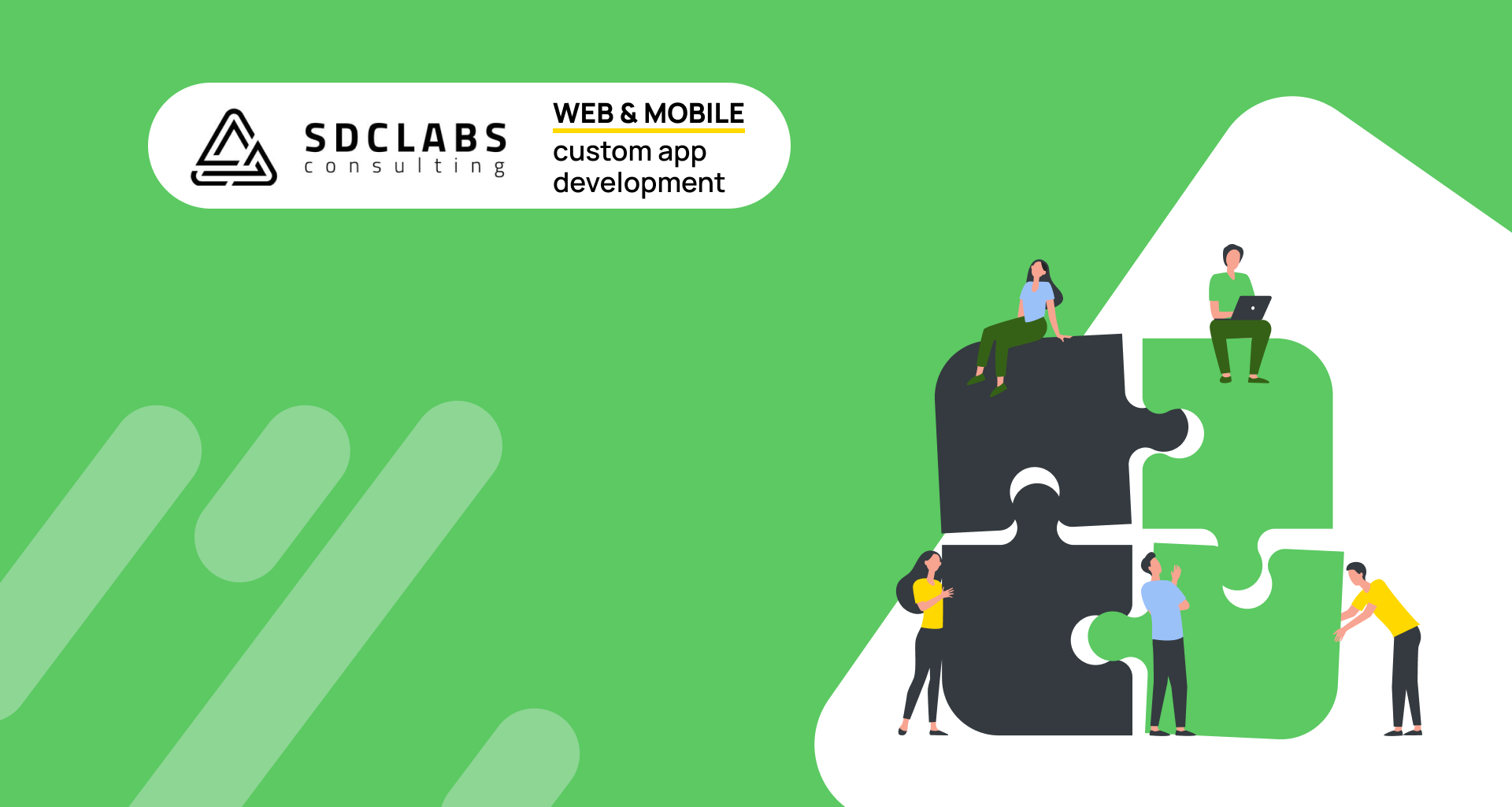The development of digital products for business is almost the most demanded industry in the modern world. According to analysts Grand View Research, the total market value will exceed $1.1 trillion by 2030, driven by an estimated 11.7% CAGR between 2022 ($470 billion) and 2030. Such industry development became possible thanks to the global digitalization of business and its adaptation to the current user needs.
App development is a multi-layered work of architecture, design, integration, testing, debugging, and support of a digital solution. Theoretically, one expert can handle all the tasks, but it will take a lot of time, although the quality of such a product will remain at a relatively low level, especially if a complex app with a large set of functions is planned.
To implement a full-fledged project, all of its components, and provide a high level of comfort for a digital solution requires a full-scale development team software. What kind of people are typically involved in the development, and how many people do you need to implement different types of an app? Let’s figure it out.
Development Team Members
Classic outsourced software development organizational structure implies the participation of all those experts whose technology profile is involved in the project. For example, a complex service consists of such stages as:
- Industry analysis.
- Consulting.
- Tech stack selection.
- Create a design layout.
- Writing business logic.
- Building a back-end architecture.
- Implementation of front-end elements.
- Setting up a cloud platform.
- Creation and connection of DB.
- Integration of modules via API.
- Testing of all elements.
- Market launch and further support.
According to these tasks, the team needs:
- Business analysts.
- Designers.
- Front end and back end developers.
- DB Architects.
- Testers.
- Project Manager.
- Teamlead.

Depending on the type of app and its technical stack, this composition can vary, reducing to 2-3 participants or expanding to 9+. Teams of 12+ specialists are sometimes involved in working on a large project using Agile methodology, but the full development group may include more than two separate teams. We suggest looking at the role of each participant in more detail.
Each Participant’s Role
The peculiarity of creating digital solutions is that for implementing each element, a specialist of a particular profile is needed as part of the software development team structure. You can delegate the project to a universal contractor, but its final quality is unlikely to compete with the release of a full-fledged team, where each member is responsible for a single component.
Business Analyst
The role of the consultant and analyst is significant. Their expertise determines the scale of the app, its orientation, functions, and even the interface’s appearance. This participant analyzes the market, competitors’ solutions, and end-user requests, creating a picture of the business model. They also determine the profitability of the project and its prospects. That is why it is ideal to have such a specialist as a full team.
Designer
Complex appearance, icon color, background gradient, shape of interface elements, and animation are all areas of responsibility of a UX expert. Their main task is to package the app in a presentable shell. Modern teams necessarily include a designer in their composition because they are the only one who can harmoniously combine all the visual effects into a single system. Designers create the way how users will use the product. UX designers leverage a wide range of technical and workplace skills to bring a successful product or service to market (or improve upon an existing product).
Back-end Developer
The main link in the development that determines everything literally: from the organization of the app architecture and relationships to fitting the code to the requirements of the customer’s business logic. Programming in PHP, Java, JavaScript, Ruby, Python, and C#, they practically create from scratch a program framework and its invisible part – server logic. Yes, there are web solutions based solely on the front-end, but the back-end is needed to implement complex functionality.
Front-end Developer
A master of frameworks and development languages that implements features, interface elements, and even some external integrations. The coherence of all components’ work and the app’s adaptation to various screen formats depend on their actions. Also, front-end specialists are responsible for implementing the graphics processing system (framework-based graphics engine) and the correct display of functional elements: input fields, control panels, individual buttons.
DB Architect
One of the most critical contributors to developing complex apps and systems. Creates stand-alone or integrated databases, realizing a seamless exchange of information between all components (back-end, front-end, and DB). Such functionality is necessary particularly for marketplaces, web stores, and any other digital solutions that need catalogs, descriptions, or remote management of individual data arrays.
QA Engineer
The role of a tester is often downplayed, although the final quality of an IT product depends on them. This particular member is responsible for comprehensive testing of the entire app, including functionality, interface, logical connections, I/O operations, etc. Saving on a QA service often leads to sad consequences, from bad reviews to a complete failure of a digital solution in the market.
Teamlead
A workflow organizer under whose leadership all development participants are. Responsible for deadlines, product quality, management, reports, and tasks. No team can self-organize at the level provided by the team leader. This is a challenging position because, in addition to leadership qualities, a specialist must understand the methodology, the features of each participant’s work, and development technologies.
Project Manager
The second person after the customer or the development manager. They are accountable for all aspects of the project. The main task is to control quality, deadlines, and edits. The project manager is directly involved in the development process.
All listed software development roles are essential components of a full-fledged team. Without them, the implementation of the project may be delayed or not take place at all. The exclusion of even one participant when working on a complex platform will lead to a deadline shift and, accordingly, financial losses.
Types of Development Teams
Conventionally, development teams can be divided into 4 types: process improvement, working groups, self-managed and complex. Each performs certain processes and solves specific problems. Depending on the service classification, contractors can implement one or another part of the development, but additional contractors must be involved to cover all needs. This applies to all types except complex. Let’s look at their specifics.
Process Improvement Team
This type of organization has well-defined functions and performs a narrow range of tasks. For example, a retail business needs a working showcase app with chat, filters, and a payment system. The team gathers, analyzes the market, brainstorms, and offers its implementation option. Often it performs only specific tasks and develops a specialized digital solution. Their responsibilities do not include modernization, scaling, or the creation of complex platforms, except in cases where work conditions imply these processes.
This type of company suits business representatives who know their exact position and do not pretend to create much competition in a niche. In fact, these are startups and small retail stores that need their own IT solution to expand their consumer base.
Workgroup
This type of organization refers more to full-time employees who are part of a large team. They are responsible for a specific area of work and perform limited functions. For example, a mobile solution development department for one chosen platform, when their colleagues create a digital product for the second one, is a classic example of a workgroup. This option is more suitable for large companies that need to break down tasks and ensure their high-quality performance.
Self-managed Team
An interesting variant of the organization in which all participants in the development process complement each other’s skills and cooperate to achieve the best result. Contrary to the name, there is a team leader who performs their direct duties: coordinates the work, distributes roles, and monitors the progress. This type of team is often found among representatives of the Agile methodology, who value the flexibility of the process and the speed of adaptation to changing tasks.
Comprehensive Team
Bright representative of Agile and DevOps methodologies. Provides a full range of services: from market analytics to post-release maintenance of a digital solution. This type of team has a clearly defined structure with a strict distribution of roles when each participant is entirely focused on solving their problems. At the same time, in such an organization, full coordination of actions is often found; for example, if a certain part of the work is not completed on time, then all free colleagues join its finalization and solve the set goal to the best of their ability and skills.
Summarizing
Developing digital solutions is a complex and responsible task that affects the success of a business as a whole. A team with relevant experience and composition should be selected for it. We recommend hiring contractors who provide comprehensive services with an entire cycle of work on the project: from analysis and planning to scale and support. Such a partner will allow you to delegate the main tasks to the contractor and focus on your own business processes.
SDCLabs provides a full cycle of development services and provides such a level of quality for an IT solution that leaves the customer with no dissatisfied digital clients. We do not just analyze the market but also build a plan that will help you outperform your main competitors. We use only proven flexible technologies in development, diluting them with innovative solutions. Working with us, you get a reliable partner to execute the most ambitious projects! For consultation and discussion of cooperation, please contact our manager.
